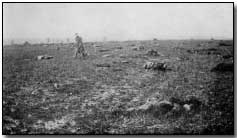Battles - The First Battle of Champagne, 1914
 The First Battle of Champagne, which after minor skirmishes began on 20 December 1914, was effectively
the first significant attack by the Allies against the Germans since the
construction of trenches following the so-called 'race to the sea' during
the autumn of 1914.
The First Battle of Champagne, which after minor skirmishes began on 20 December 1914, was effectively
the first significant attack by the Allies against the Germans since the
construction of trenches following the so-called 'race to the sea' during
the autumn of 1914.
Joffre, the French Commander-in-Chief, was determined to win the war quickly, and despite a lack of success in more local attacks against trench lines, resolved to launch a major offensive extending along the whole line from Nieuport to Verdun, throughout the Artois and Champagne regions.
In the event the winter offensive was primarily directed against a notable salient, the Sayon Salient, which the Germans had forced into central France from Reims to Verdun; a smaller salient also existed further south at St. Mihiel.
Joffre's plan involved a numerically superior attack against the German Third Army on the Sayon salient at its most northern and southerly edges, to be followed by an advance through the Ardennes, intended to cut off a potential German retreat, the whole offensive aided by a supporting attack from the River Yser through to Verdun.
 The
offensive was launched with minor attacks on 10 December 1914 at the southern edge of the
Sayon
salient, near Perthes in eastern Champagne. Despite heavy fighting -
at Givenchy from 18-22 December, Perthes on 20 December, and at Noyon on 22
December - French gains were minimal. Despite being outnumbered in
terms of troops, the German lines were efficiently entrenched, and
successfully demonstrated the superiority of the then state of defensive
warfare, especially in their use of the
machine gun. The separate
attack from the Yser proved a costly failure, notably at Artois and the
Woevre.
The
offensive was launched with minor attacks on 10 December 1914 at the southern edge of the
Sayon
salient, near Perthes in eastern Champagne. Despite heavy fighting -
at Givenchy from 18-22 December, Perthes on 20 December, and at Noyon on 22
December - French gains were minimal. Despite being outnumbered in
terms of troops, the German lines were efficiently entrenched, and
successfully demonstrated the superiority of the then state of defensive
warfare, especially in their use of the
machine gun. The separate
attack from the Yser proved a costly failure, notably at Artois and the
Woevre.
Fighting continued without break until mid-February when a brief lull in the battle - to re-organise - was resumed until 17 March when the entire offensive was called off by the French owing to the strength of German counter-attacks (particularly along the La Basse Canal and near Soissons from 8 January-5 February), combined with a costly lack of success. Perthes had in particular seen much action, with an additional three battles being fought for its possession.
The French had made minor territorial gains across the line - the French Fourth Army had made progress on the hills of eastern Champagne - but at no point greater than 3 km - which, judged by Joffre's aims, was less than adequate. French casualties numbered some 90,000; the German Third Army lost an equivalent number.
Despite this setback Joffre was convinced that the German lines were vulnerable to massed infantry assault, particularly given the knowledge that German forces were being transferred to the Eastern Front to conduct the battle against Russia.
Joffre therefore determined to continue the wider offensive at the northern edge of the Sayon salient; he later resumed the Champagne offensive in the autumn of 1915.
Click here to view a map of the German retreat following the Marne battle, the subsequent race to the sea and the resultant stabilised trench lines.
Photographs courtesy of Photos of the Great War website
"Drum Fire" was an artillery barrage fired not in salvo but by each gun in succession.
- Did you know?
